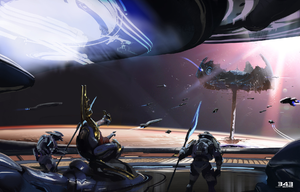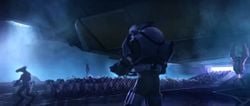The Covenant
From Halopedia, the Halo wiki
| The Covenant | |
|---|---|
| File:Covenantflag.jpg | |
| Government overview | |
|
Type: |
Theocratic cultural hegemony |
|
Founder(s): |
|
|
Founding documents: |
|
|
Head of state: |
|
|
Executive branch: |
|
|
Legislative branch: |
High Council[2] |
|
Government branches: |
|
| Societal overview | |
|
Capital: |
|
|
Official language(s): |
|
|
Official religion(s): |
|
|
Official script(s): |
Syllabary and logograms |
|
Notable event(s): |
|
| Historical overview | |
|
Formation: |
852 BCE: First Age of Reconciliation[1] |
|
Dissolution: |
|
- "Creatures of the Covenant: the path is broad, and we shall walk it side by side!"
- — The High Prophet of Truth[5]
The Covenant, also referred to as the Covenant Empire[6][7] or Covenant Hegemony,[8] was a religious hegemony of multiple alien species that controlled a large portion of the Orion Arm in the Milky Way Galaxy. Originally a mutual alliance between the San'Shyuum and the Sangheili, the Covenant expanded to include at least six other species united in the worship of the Forerunners and the Halo Array.
They waged a genocidal campaign against humanity until they were defeated in December of 2552. Despite being ostensibly the most powerful military force in the known Milky Way galaxy at the time, internal conflict combined with stubborn human resistance were formidable enough to shatter the bonds that held the empire together. While the Covenant Empire ended either during the Flood infection of High Charity or during the Battle of Installation 00, a number of remnant factions, some of which maintain many of the ideals of the Covenant's religion as well as many of its former subject species, continue to exist after the conclusion of the war.[9][10]
History
- Main article: History of the Covenant
- "The First Age: Ignorance and Fear.
- The Second Age: Rivalry and Bloodshed.
- The Third Age: Humility and Brotherhood.
- The Fourth Age: Wonder and Understanding.
- The Fifth Age: Obedience and Freedom.
- The Sixth Age: Faith and Patience.
- The Seventh Age: Journey and Salvation.''"
- The Sixth Age: Faith and Patience.
- The Fifth Age: Obedience and Freedom.
- The Fourth Age: Wonder and Understanding.
- The Third Age: Humility and Brotherhood.
- The Second Age: Rivalry and Bloodshed.
- — Maccabeus and the Jiralhanae of the Rapid Conversion.[11]
The Covenant created its own means of connoting time, comprised of "Ages." The Covenant's history is broken up into multiple occurrences of seven types of Age, each representing the predominant theme that occurred during those periods of time. These ages do not necessarily follow one another in order, nor are they equal in quantity. As an example, there were significantly more Ages of Conflict and Doubt than Reclamation. Each Age is further broken into what is called cycles. A cycle is the Covenant version of a day and it represents one artificial day on High Charity. A cycle contains approximately 265 units, which if translated into human time is roughly one hour of time on Earth.[12]
Foundation
- Main article: War of Beginnings
At some point before the San'Shyuum encountered the Sangheili, the Huragok were found by the San'Shyuum in various M-series facilities.[13] In 938 BCE,[1] the San'Shyuum Reformists, aboard the Forerunner Dreadnought and the planetoid that would come to be known as High Charity, entered a Sangheili-occupied system that led to first contact between the two alien species. The San'Shyuum, who came to Sanghelios in order to claim and study the rich abundance of Forerunner artifacts left behind,[14] soon found themselves sharing different ideologies of how such relics should be treated, which quickly devolved into conflict between the San'Shyuum and the Sangheili.
The Sangheili believed that Forerunner relics were sacred and should not be touched, while the San'Shyuum Reformists believed that they should be studied and use them to make practical objects of their own design.[15] The highly-militarized Sangheili attacked the San'Shyuum almost as soon as their differences became apparent,[16] and a war between the two species raged for eighty six years.[1]
At the start of the war, the Sangheili had a numerical advantage in terms of ships and soldiers. Their strength and military tactics were without peer. However the San'Shyuum's technology, gleaned from years of travel and study of their Forerunner Dreadnought, gave them the advantage in ship-to-ship combat. This proved to be the most common type of combat witnessed during the war.[16]
Eventually both species came to fear a very real threat: annihilation. The Sangheili feared it through the San'Shyuum's use of their unstoppable Dreadnought; and the San'Shyuum came to admit that if the Sangheili were this dangerous, there might be other forms of sentient life far more threatening to their race.[16] The long and brutal war caused the Sangheili to violate their religious beliefs, studying and incorporating Forerunner technology in order to avoid defeat.[16] This incorporation of Forerunner technology eventually caused a stalemate in the war against the San'Shyuum,[16] however their Dreadnought remained unstoppable. Faced with this bitter reality, the Sangheili surrendered.[14]
With a proud tradition as warriors, the Sangheili held great respect for a worthy adversary, and after their surrender, the San'Shyuum sought to seek a burgeoning Covenant of the two races. In 852 BCE a tentative truce was worked out between the two species through the Sangheili leader, Pelahsar the Strident, and the San'Shyuum Breaking Shadow. The two agreed to forgive the past crimes of their species and began efforts towards an alliance.[17] This eventually came about with the signing of the Writ of Union, a treaty that ended the conflict and brought about peace between the two factions.[1]
Contact and conversion
- "Most of those we encountered in our search were compelled to join our Union. To take part in a movement that promised freedom for allegiance, salvation for service!"
- — The Prophet of Regret[18]

The conclusion of the conflict marked the First Age of Reconciliation, followed by the First Age of Conversion. This period was exemplified by the Covenant's expansion throughout the galaxy. In 784 BCE, the Lekgolo were encountered by the Covenant on Rentus, a natural satellite of the Lekgolo homeworld of Te.[19] Upon the discovery that many of the Lekgolo worm colonies had literally devoured Forerunner artifacts and installations, a large-scale military conflict began. The Lekgolo initially proved difficult to defeat because of their ability to combine into the powerful Mgalekgolo, however due in part to their superior spaceship technology the Covenant was able to ally with the useful Lekgolo and the species was indoctrinated into the hegemony.[20][21] In the year 1112, the Covenant discovered the Yanme'e, an insectoid race with an interplanetary civilization. First contact was violent as both sides took heavy casualties. However, it was the Covenant who fared worse in these battles. Ultimately, the San'Shyuum discovered a way to communicate with the Yanme'e, and subsequently incorporated them into the Covenant by way of a treaty.[22]
In 1342, the Covenant arrived in the Y'Deio system and encountered the Kig-Yar. Both Kig-Yar pirates and Eayn's militia joined forces in an attempt to fend off the Covenant military juggernaut. The war between the Covenant and Kig-Yar forces culminated in sieges of redoubts on the asteroids surrounding their world,[23] however the asteroids proved to be beneficial to the Kig-Yar. It was difficult for the larger Covenant ships to maneuver through Y'Deio's abnormally dense asteroid belt, while Kig-Yar forces could use the asteroids for hiding.[24] Eventually, peace was reached between the Kig-Yar and Covenant. The Kig-Yar joined the Covenant, essentially as mercenaries, and earned commissions from the Ministry of Tranquility to engage in the services of the Covenant.[25] The Unggoy were easily inducted into the Covenant as a labourer race in 2142. In 2462, the Unggoy Rebellion began after the Ministry of Concert refused to punish Kig-Yar shipmasters that were rendering Unggoy populations infertile as petty revenge for the displacement of Kig-Yar nests. The Unggoy proved to be vicious, determined and competent fighters and an Arbiter was ultimately needed to quell the rebellion. This Arbiter ordered the glassing of .
- ^ a b c d e Halo Encyclopedia, page 30
- ^ a b Halo Waypoint: High Council
- ^ Halo 3 - The Covenant (level) - The Covenant was defeated on the Ark during the Battle of Installation 00.
- ^ Halo Wars 2 GAMEPLAY - E3 2016 Interview (Interview with Kevin Grace) - "The Covenant are dead"
- ^ Halo 2 level Gravemind
- ^ Halo: Ghosts of Onyx, page 239
- ^ Halo: First Strike, page 269 (2003 edition); page 323 (2010 edition)
- ^ Halo: First Strike, page 338 (2003 edition); page 405 (2010 edition)
- ^ Halo 4 Interactive Guide
- ^ Halo 3, Assembly description
- ^ Halo: Contact Harvest page 196-197
- ^ Halo Encyclopedia page 31
- ^ Halo 3, Bestiarum
- ^ a b Halo Encyclopedia page 114
- ^ Halo: Contact Harvest page 146
- ^ a b c d e Halo: Contact Harvest page 147
- ^ Halo Mythos, page 39
- ^ Halo 2, campaign level Regret
- ^ Halo Waypoint: Catalog Interaction (post 2988575)
- ^ Halo Encyclopedia, page 114
- ^ Halo: Contact Harvest, pages 269-271
- ^ Halo Encyclopedia, pages 148-149
- ^ Halo Encyclopedia, page 155
- ^ Halo: The Cole Protocol, page 157
- ^ Halo Encyclopedia, page 121

